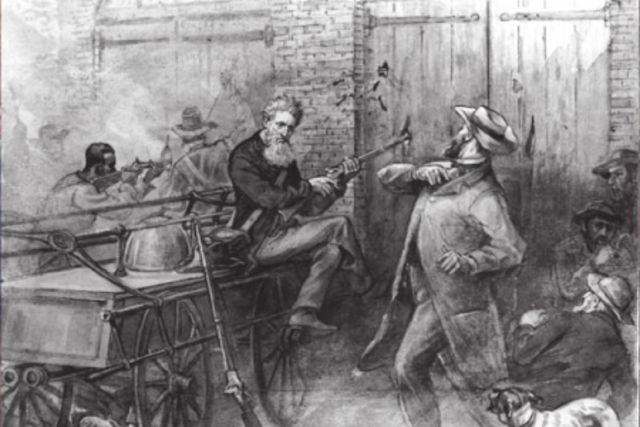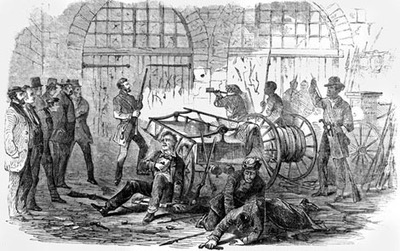

Crook, a veteran of Bloody Kansas Dangerfield Newby, a formerly enslaved man whose wife and children remained in captivity Osborne Perry Anderson, a free Black man living in Canada and Francis Jackson Meriam, the grandson of a prominent abolitionist who joined Brown despite being blind in one eye. In addition to three of his sons, other volunteers included John E. Now a wanted fugitive, he had come to believe that for slavery to end, he would need to take the fight to the enslavers.

Source: Library of CongressĪfter masterminding the escape of several enslaved people from Missouri to Canada, Brown began planning his next move. His time in the territory helped convince Brown to open a new front in the war against slavery. Pro-slavery and free soil forces clash in Kansas. During the battle, pro-slavery forces killed his son, Frederick. Brown then participated in the unsuccessful defense of the antislavery community in the town of Osawatomie, earning himself the nickname Osawatomie Brown. The victims had no chance to defend themselves, and the violence shocked many free soil adherents. On the night of May 24, 1856, Brown and a group of accomplices raided the cabins of several of their pro-slavery neighbors and brutally murdered five men. After a spate of violent attacks by pro-slavery attacks on free soilers, Brown, shocked, horrified, and worried about his family’s safety, decided to strike back. Brown traveled to Kansas at the urging of his sons to aid the free state cause. At the time, the territory was engulfed in a brutal conflict called, “Bleeding Kansas,” which pitted settlers who wanted Kansas to join the Union as a slaveholding state against “free soilers” who wanted it to enter as a free state.

After taking the town, the group would march into the mountains to commence a guerrilla war against slavery itself, with the hope of creating an army of the self-liberated that would compel the United States to end the institution once and for all.Ī lifelong abolitionist, Brown had never fired a weapon at another person before he traveled to Kansas in the early 1850s. Led by abolitionist John Brown, their goal was to reach the federal armory and arsenal in Harpers Ferry, a town in present-day West Virginia (at the time, part of Virginia).

#Raid of harpers ferry timelime full
Past darkened farms, houses, and buildings, the group quietly pushed a wagon full of weapons. On the night of October 16, 1859, a group of 22 men made their way along a winding road in western Maryland. When it was learned that prominent Northerners (the “secret six”), who had to have known of Brown’s character, had bankrolled his expedition, some Southerners understandably concluded that they were so hated by the North that the section would hardly regret, and might even welcome, their departure from the Union.An extremely devout man, John Brown saw slavery as a war against the enslaved and believed it went against both the Bible and the Declaration of Independence. Historian Stephen Channing showed in his book Crisis of Fear (1974) how fears and suspicions regarding Northern intentions and behavior in the wake of John Brown’s raid contributed to South Carolina’s decision to secede from the Union in 1860. Virginia secessionist Edmund Ruffin, for example, distributed throughout the Southern states some cast-iron pikes that Brown had brought with him, along with a label that read, “Sample of the favors designed for us by our Northern brethren.” Despite Lincoln’s protestations to the contrary, and a statement in the Republican Party’s platform condemning Brown’s raid, many Southerners suspected Republican sympathy for Brown. Not surprisingly, Southerners at this point grew concerned about their safety in the Union. He and six followers were sentenced to death and hanged. Brown surrendered after ten of his followers had been killed. It was a spectacular failure: Brown and his supporters found themselves surrounded by hostile local citizens, militiamen, and even U.S. In October 1859, Brown and nineteen followers seized the federal arsenal at Harpers Ferry to foment and equip a massive slave insurrection throughout the South. Following this gruesome episode Brown became a fugitive, only resurfacing in 1859 when he planned a strike against slavery that he hoped would be far more systematic and effective than the murders he had perpetrated in Kansas. His methods were terrifying: In each case, he and his followers dragged the man of the house from his bed and butchered him as his family screamed in horror. Brown and his companions targeted five families-none of whom owned any slaves- who in Brown’s view were loyal to the wrong Kansas faction.


 0 kommentar(er)
0 kommentar(er)
